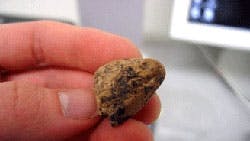Laser scanning helps decipher cuneiform tablets
Researchers are one step closer to understanding a culture and people that lived about 4,000 years ago in Mesopotamia, in the region of modern-day Iraq and Iran. The Department of Anthropology and Archaeology at Brooklyn College, part of the City University of New York (CUNY), is developing a new approach for the study of ancient cylinder seal impressions and clay tablets bearing cuneiform inscriptions, Mesopotamia’s early form of writing. In the past, the department used a Laser Design Surveyor 3D scanning system from Laser Design Inc. (LDI), Minneapolis, to document primate fossil shapes. Now, the department is using the same system to scan ancient tablets as well.
In a pilot research project, a series of cuneiform tablets, each a 1.5-in. handmade triangle of clay bearing Akkadian language, was scanned with the LDI laser scanning system, and digital models were created. Then, these models were measured so that each cuneiform sign was accurately described by digital data. Because of their small size, each tablet required only one or two scan passes to create an accurate 3D model. However, scanning, modeling, and then analyzing the data from the artifacts took about a year to complete. Details captured during the pilot project include the precise characteristics of each wedge (length, breadth, depth, and volume), and the spatial relationships between and among wedges.
Non-contact laser scanning is suitable for the freeform detailed shapes of the tablets, because it tracks even tiny changes in surface texture: The system projects a line of laser light onto surfaces while cameras continuously triangulate the changing distance and profile of the laser line as it sweeps along, so no data is missed, even on irregular surfaces. This laser line moves back and forth over the part until the complete surface is captured; the system picks up tens of thousands of points per second to generate huge numbers of data points without templates or fixtures.
LDI’s software, Surveyor Scan Control (SSC), controls the scanning motions, manages the laser probe settings, and contains advanced automation features for their units. The rotary stage allows the system to automatically scan parts from all orientations and then merge the data into a common coordinate system. After the pilot-program cuneiform tablet scans, resulting data was processed further with Geomagic Raindrop software to quickly make surface models — in essence, reverse engineering the tablets digitally. So for the anthropology and archaeology researchers now, the goal is to develop a battery of techniques that will make “cuneiform forensics” possible — to analyze cuneiform tablet markings as if they were handwriting, and develop a database of the 3D measurements to study their physical as well as linguistic elements.
Visit Laser Design for more information.
